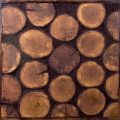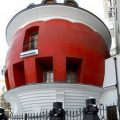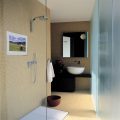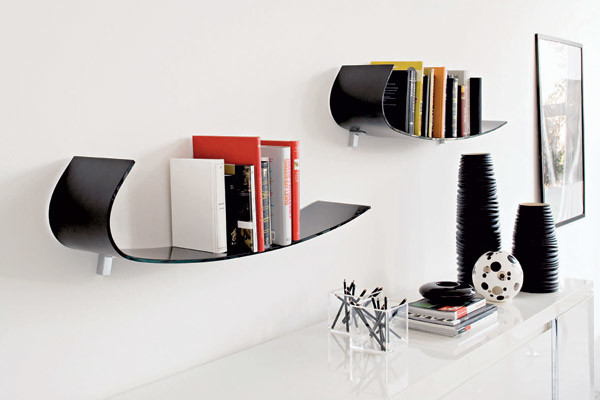 Glass furnitureThe trend is obvious:More and more furniture factories produce items from glass or its artificial analogue thermoplastic. And this is to our advantage, the buyers, because transparent materials are so multifaceted that even the simplest things made from them acquire a different sound, borrowing from the original raw material the ability to visually expand space and refract streams of light. If previously the range of glass furniture was limited to shelves, now it includes coffee and end tables (Occa 4450 by BoConcept, Denmark; Milan by Europe, Russia), dining tables (Ray by Catttelan Italia, Italy), shelving units (Transfix by Glas Italia, Italy) and even headboards (model Prima by Natif, Russia). The range of thermoplastic products is wider – It is used to make chairs and armchairs (Alchemia by Calligaris, Pauline by Soft Line, Poly by Bonaldo, all in Italy), stools (Luisa by Soft Line, Denmark), shelving units (Algas by Uno Design, Spain) and even sofas (Pop by Kartell, Italy). Glass and thermoplastic differ in price. It's all about the different properties of these materials and the complexity or, conversely, simplicity of their processing methods.
Glass furnitureThe trend is obvious:More and more furniture factories produce items from glass or its artificial analogue thermoplastic. And this is to our advantage, the buyers, because transparent materials are so multifaceted that even the simplest things made from them acquire a different sound, borrowing from the original raw material the ability to visually expand space and refract streams of light. If previously the range of glass furniture was limited to shelves, now it includes coffee and end tables (Occa 4450 by BoConcept, Denmark; Milan by Europe, Russia), dining tables (Ray by Catttelan Italia, Italy), shelving units (Transfix by Glas Italia, Italy) and even headboards (model Prima by Natif, Russia). The range of thermoplastic products is wider – It is used to make chairs and armchairs (Alchemia by Calligaris, Pauline by Soft Line, Poly by Bonaldo, all in Italy), stools (Luisa by Soft Line, Denmark), shelving units (Algas by Uno Design, Spain) and even sofas (Pop by Kartell, Italy). Glass and thermoplastic differ in price. It's all about the different properties of these materials and the complexity or, conversely, simplicity of their processing methods.
Caution glass?
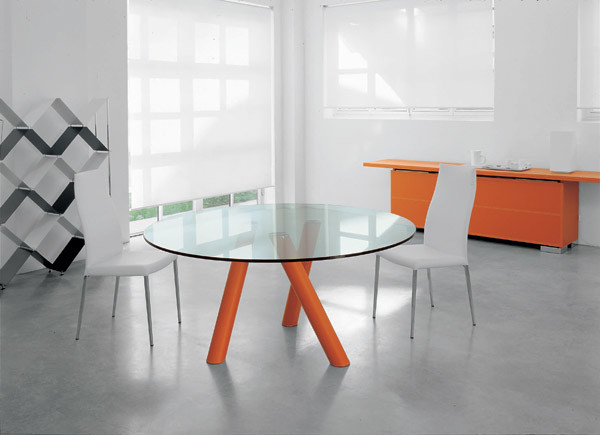 Furniture made of plasticIt is believed that glassfurniture is closest to the aesthetics of high-tech. Transparent glass and polished metal are indeed most appropriate in cold space interiors. However, others will fit optimally into rooms designed in more human-friendly styles. The simplest in configuration and neutral in style furniture are tables, shelves, TV stands. All of them are made of cast cut glass plates. By the way, the thicker the glass blank, the more expensive the product will be. Furniture of more intricate shapes is made of bent (fused) glass. It is more complex and more expensive to manufacture, and therefore also in price. The glass surface can be made matte, or an intricate pattern can be applied to it using sandblasting. Another decorative technique is the effect of broken, cracked glass, which looks very interesting and unusual. The edges and corners of glass furniture are processed, giving them a safe figured shape. Glass is a good "companion", so it is often combined with wood or metal. For example, dining tables with a glass top are usually made with wooden or metal legs. In lighter coffee tables or coffee tables, a combination of glass and thermoplastic is often used for the same purpose. In the production of shelving and bookcases, glass is combined either with metal or with laminated, veneered or painted chipboard or MDF (Charme from Cattelan Italia, Maila from Nueva Linea, Spain). A shelving unit is one of the most bulky and substantial pieces of furniture. However, when placed along a wall, it visually practically does not clutter up the space. Another matter is chairs, armchairs and armchairs, which, from the point of view of the apartment dwellers, are never too many. They are capable of literally filling the room. Of course, you can't make them out of glass, but manufacturers have found a worthy replacement for it - various thermoplastics. Caring for glass furniture Do you often wipe the dust on the inner surfaces of cabinet furniture? No. You shouldn't be lazy with transparent shelves, racks, display cases and partitions, otherwise their qualities - to transmit and refract light - will be leveled by a layer of dust that accumulates inside glass furniture in the same quantity as outside.
Furniture made of plasticIt is believed that glassfurniture is closest to the aesthetics of high-tech. Transparent glass and polished metal are indeed most appropriate in cold space interiors. However, others will fit optimally into rooms designed in more human-friendly styles. The simplest in configuration and neutral in style furniture are tables, shelves, TV stands. All of them are made of cast cut glass plates. By the way, the thicker the glass blank, the more expensive the product will be. Furniture of more intricate shapes is made of bent (fused) glass. It is more complex and more expensive to manufacture, and therefore also in price. The glass surface can be made matte, or an intricate pattern can be applied to it using sandblasting. Another decorative technique is the effect of broken, cracked glass, which looks very interesting and unusual. The edges and corners of glass furniture are processed, giving them a safe figured shape. Glass is a good "companion", so it is often combined with wood or metal. For example, dining tables with a glass top are usually made with wooden or metal legs. In lighter coffee tables or coffee tables, a combination of glass and thermoplastic is often used for the same purpose. In the production of shelving and bookcases, glass is combined either with metal or with laminated, veneered or painted chipboard or MDF (Charme from Cattelan Italia, Maila from Nueva Linea, Spain). A shelving unit is one of the most bulky and substantial pieces of furniture. However, when placed along a wall, it visually practically does not clutter up the space. Another matter is chairs, armchairs and armchairs, which, from the point of view of the apartment dwellers, are never too many. They are capable of literally filling the room. Of course, you can't make them out of glass, but manufacturers have found a worthy replacement for it - various thermoplastics. Caring for glass furniture Do you often wipe the dust on the inner surfaces of cabinet furniture? No. You shouldn't be lazy with transparent shelves, racks, display cases and partitions, otherwise their qualities - to transmit and refract light - will be leveled by a layer of dust that accumulates inside glass furniture in the same quantity as outside.
Sculpture in plastic
 It is used in the furniture industryThere are several thermoplastics, but two are the most popular: polycarbonate and polymethyl methacrylate (PMMA), also known as organic glass, acrylic glass and plexiglass. (The material received the latter name from the Plexiglas trademark, which is the most famous manufacturer of PMMA.) PMMA was invented as an alternative to ordinary glass and turned out to be no less worthy than the sample. Moreover, acrylic glass even leads in some properties. It is significantly lighter, cheaper, much stronger and easier to process. In addition, PMMA can be bent and given any shape. But acrylic glass also has its drawbacks. For example, PMMA is sensitive to liquids containing alcohol or other solvents. In addition, it is easily scratched and transmits light worse than ordinary glass. Another thermoplastic, polycarbonate, is more translucent and durable and, accordingly, is more expensive. Unlike mineral glass, thermoplastics are rarely combined with other materials. Usually, as a companion, it is used as a thermoplastic. They use metal, but perhaps only for support legs and guides in shelving units. If you want to support a domestic manufacturer, then in the case of thermoplastic furniture, you will not be able to do so. They still know how to make it abroad.Caring for thermoplastic furnitureTo avoid scratches, use only a soft cloth for cleaning, or better yet, a sponge slightly moistened with water in which a neutral detergent has been dissolved. Any solvents and alcohol-containing liquids are prohibited!
It is used in the furniture industryThere are several thermoplastics, but two are the most popular: polycarbonate and polymethyl methacrylate (PMMA), also known as organic glass, acrylic glass and plexiglass. (The material received the latter name from the Plexiglas trademark, which is the most famous manufacturer of PMMA.) PMMA was invented as an alternative to ordinary glass and turned out to be no less worthy than the sample. Moreover, acrylic glass even leads in some properties. It is significantly lighter, cheaper, much stronger and easier to process. In addition, PMMA can be bent and given any shape. But acrylic glass also has its drawbacks. For example, PMMA is sensitive to liquids containing alcohol or other solvents. In addition, it is easily scratched and transmits light worse than ordinary glass. Another thermoplastic, polycarbonate, is more translucent and durable and, accordingly, is more expensive. Unlike mineral glass, thermoplastics are rarely combined with other materials. Usually, as a companion, it is used as a thermoplastic. They use metal, but perhaps only for support legs and guides in shelving units. If you want to support a domestic manufacturer, then in the case of thermoplastic furniture, you will not be able to do so. They still know how to make it abroad.Caring for thermoplastic furnitureTo avoid scratches, use only a soft cloth for cleaning, or better yet, a sponge slightly moistened with water in which a neutral detergent has been dissolved. Any solvents and alcohol-containing liquids are prohibited!
What's what
 Our examples will help to get an idea of the price spread of transparent furniture.
Our examples will help to get an idea of the price spread of transparent furniture.
- Glass Top Tables Dining Table"Milan" (Europe) with a glass tabletop on a metal base and legs will cost the buyer approximately 21,300 rubles, and the T-6 (Natif) coffee table with a frosted glass tabletop on massive wooden supports will cost approximately 23,500 rubles. By the way, foreign production of a dining or coffee table should not make you refuse to buy it in absentia. This is not an indicator of a high or, conversely, low price. For reference: the Occa 4450 (BoConcept) coffee table made of curved transparent glass will cost a little more than the domestic one mentioned, RUB 25,400.
- Glass Shelves and Racks HereWestern companies have virtually no competitors in our market, and therefore the cost will be high. However, you can refuse to buy them in favor of book shelves or racks made of thermoplastic. They are much more diverse in shape, and more affordable in price. For example, the Bookworm shelf (Kartell) with seven book stands will cost about 10 thousand rubles, and the Algas TV stand rack (Uno Design) - about 18 thousand rubles.
- Plastic chairs As for PMMA chairsor polycarbonate, then their cost is slightly lower than that of their counterparts made from traditional materials. For example, a Pauline chair (Soft Line) will cost approximately 4,500 rubles, while Calligaris and Kartell products will cost about half as much.
Can plastic furniture be used outdoors?If you have thermoplastic furniture in your home, you might want to save on your garden furniture. However, transparent items are UV-resistant, but not strong enough to withstand direct sunlight. Moreover, plastic furniture is exposed to rain, dust, and sand outdoors. These won’t have a positive effect on its appearance either.Where to buyBoconcept, store addresses here.WWTS, tel.: (495) 789 6871, dealer addresses. Furniture factory "Europe", tel.: (495) 961 3063, showrooms in Moscow. Natif showroom, Rublevskoe sh., 52A, TC "Zapadny", tel.: (495) 967 3063, the opening of the showroom at this address will take place on March 15, 2008. Details here. IKEA company, store addresses.





